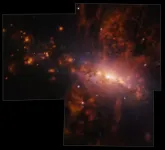(Press-News.org) A team of international researchers studied galaxy NGC 4383, in the nearby Virgo cluster, revealing a gas outflow so large that it would take 20,000 years for light to travel from one side to the other.
The discovery was published today in the journal Monthly Notices of the Royal Astronomical Society.
Lead author Dr Adam Watts, from The University of Western Australia node at the International Centre for Radio Astronomy Research (ICRAR), said the outflow was the result of powerful stellar explosions in the central regions of the galaxy that could eject enormous amounts of hydrogen and heavier elements.
The mass of gas ejected is equivalent to more than 50 million Suns.
“Very little is known about the physics of outflows and their properties because outflows are very hard to detect,” Dr Watts said.
“The ejected gas is quite rich in heavy elements giving us a unique view of the complex process of mixing between hydrogen and metals in the outflowing gas.
“In this particular case, we detected oxygen, nitrogen, sulphur and many other chemical elements.”
Gas outflows are crucial to regulate how fast and for how long galaxies can keep forming stars. The gas ejected by these explosions pollutes the space between stars within a galaxy, and even between galaxies, and can float in the intergalactic medium forever.
The high-resolution map was produced with data from the MAUVE survey, co-led by ICRAR researchers Professors Barbara Catinella and Luca Cortese, who were also co-authors of the study.
The survey used the MUSE Integral Field Spectrograph on the European Southern Observatoryʼs Very Large Telescope, located in northern Chile.
"We designed MAUVE to investigate how physical processes such as gas outflows help stop star formation in galaxies,” Professor Catinella said.
"NGC 4383 was our first target, as we suspected something very interesting was happening, but the data exceeded all our expectations.
“We hope that in the future, MAUVE observations reveal the importance of gas outflows in the local Universe with exquisite detail.”
END
Giant galactic explosion exposes galaxy pollution in action
Astronomers have produced the first high-resolution map of a massive explosion in a nearby galaxy, providing important clues on how the space between galaxies is polluted with chemical elements.
2024-04-22
ELSE PRESS RELEASES FROM THIS DATE:
Understanding ‘how’ pupils learn is key to tackling wandering focus in a digital age
2024-04-22
School attendance figures are dwindling, there are more pupils than ever before needing additional support, and a demanding legion of exams – all of which mean pupils are struggling to learn, an education expert has warned.
But, he suggests, with a renewed focus on the techniques of learning, pupils can be guided to success.
In a difficult environment for teachers, it is clear they need support. Failure might be inevitable in a classroom, former teacher Alex Quigley argues, but if teachers can understand why learning has failed, they can address ...
Everest mountaineer’s letters digitized for the first time
2024-04-22
Letters written by the famous mountaineer George Mallory have been made available to a global audience for the first time, in the centenary year of his fatal attempt to scale Everest.
An alumnus of Magdalene College, Cambridge, Mallory is known for purportedly replying "because it's there" when asked by a reporter why he wanted to climb Everest. There is still debate about whether he and his climbing partner Andrew ‘Sandy’ Irvine did in fact make it to the top ...
Scientists worldwide in line for US$1.1 million Frontiers Planet Prize as 2024 National Champions announced
2024-04-22
The Frontiers Planet Prize today (22 April) announced 23 National Champions drawn from science research teams across six continents in the second year of the global competition. The Prize recognizes scientists whose research contributes to accelerating solutions that ensure humanity remains safely within the boundaries of the Earth's ecosystem. The National Champions now move forward to the final round of the competition, where three International Champions will be awarded 1 million CHF each to support their research. ...
Study shows more than half of global infectious diseases experts surveyed rate influenza as the number one pathogen of concern of pandemic potential
2024-04-21
**Note: this is an early release from the ESCMID Global Congress (formerly ECCMID, Barcelona, Spain, 27-30 April). Please credit the congress if you use this story**
New research presented at the ESCMID Global Congress (formerly ECCMID) in Barcelona, Spain (27-30 April) shows that in a VACCELERATE Consortium survey study in which infectious diseases experts were asked to rank pathogens in order of their pandemic potential, influenza was considered the pathogen of highest pandemic risk, with 57% ranking influenza as number one, and a further 17% ranking it second (See full table, notes to editors).
The study is by Dr Jon Salmanton-García, University ...
Empty-handed neurons might cause neurodegenerative diseases
2024-04-20
Tokyo, Japan – Researchers from Tokyo Metropolitan University have identified how proteins collect abnormally in neurons, a feature of neurodegenerative diseases like Alzheimer’s. They used fruit flies to show that depletion of mitochondria in axons can directly lead to protein accumulation. At the same time, significantly high amounts of a protein called eIF2β were found. Restoring the levels to normal led to a recovery in protein recycling. Such findings promise new treatments for neurodegenerative diseases.
Every cell in our bodies is a busy factory, where proteins ...
Black women hospitalised in USA with blood infection resistant to last-resort antibiotic at increased risk of death
2024-04-20
Nationwide analysis of a large, geographically diverse cohort of adults in the USA suggests increased risk for hospital-acquired carbapenem-resistant enterobacterales bloodstream infections among racial and ethnic minorities may be due in part to hospitalisations for underlying comorbidities and associated with racial and biological sex inequities
**ECCMID has now changed name to ESCMID Global, please credit ESCMID Global Congress (Barcelona, Spain, 27-30 April) in all future stories**
New research being presented at this year’s ESCIMD Global Congress (formerly ...
NEC Society Statement on the Watson vs. Mead Johnson Verdict
2024-04-19
Given the litigation involving products used to feed and support the growth of preterm infants and the direct implication for infants who are at risk of and who have been affected by necrotizing enterocolitis (NEC), the NEC Society previously released a statement on the lawsuits. This statement addresses the Watson case.
Necrotizing enterocolitis is a devastating intestinal inflammatory disease that can affect premature or otherwise medically fragile infants during their first weeks and months of life. Upon diagnosis, many babies have only hours or days before their intestines become necrotic, progressing to sepsis, multisystem ...
Lemur’s lament: When one vulnerable species stalks another
2024-04-19
What can be done when one threatened animal kills another? Scientists studying critically endangered lemurs in Madagascar confronted this difficult reality when they witnessed attacks on lemurs by another vulnerable species, a carnivore called a fosa.
This dynamic can be particularly complex when the predation occurs in an isolated or poor-quality habitat, according to research from Washington University in St. Louis and the University of Antananarivo in Madagascar.
In the new paper published in Ecology and Evolution, researchers describe how they were observing small groups of critically endangered diademed ...
Surf clams off the coast of Virginia reappear – and rebound
2024-04-19
The Atlantic surfclam, an economically valuable species that is the main ingredient in clam chowder and fried clam strips, has returned to Virginia waters in a big way, reversing a die-off that started more than two decades ago.
In a comprehensive study of surfclams collected from an area about 45 miles due east from the mouth of the Chesapeake Bay, Rutgers scientists found the population to be thriving and growing. A likely reason could be that environmental conditions improved, and another possibility is that the clams adapted, ...
Studying optimization for neuromorphic imaging and digital twins
2024-04-19
Harbir Antil (PI), director of the Center for Mathematics and Artificial Intelligence (CMAI), professor of Mathematical Sciences, and Rainald Löhner (co-PI), director of Computational Fluid Dynamics Lab, professor of Physics and Astronomy, received funding from the Air Force Office of Scientific Research (AFOSR), under the prestigious DURIP program, to establish a neuromorphic imaging and digital twins lab with capabilities to design new optimization algorithms.
This project will set up the Neuromorphic Imaging and Digital Twins Lab—a first of its kind ...
LAST 30 PRESS RELEASES:
Numbers in our sights affect how we perceive space
SIMJ announces global collaborative book project in commemoration of its 75th anniversary
Air pollution exposure and birth weight
Obstructive sleep apnea risk and mental health conditions among older adults
How talking slows eye movements behind the wheel
The Ceramic Society of Japan’s Oxoate Ceramics Research Association launches new international book project
Heart-brain connection: international study reveals the role of the vagus nerve in keeping the heart young
Researchers identify Rb1 as a predictive biomarker for a new therapeutic strategy in some breast cancers
Survey reveals ethical gaps slowing AI adoption in pediatric surgery
Stimulant ADHD medications work differently than thought
AI overestimates how smart people are, according to HSE economists
HSE researchers create genome-wide map of quadruplexes
Scientists boost cell "powerhouses" to burn more calories
Automatic label checking: The missing step in making reliable medical AI
Low daily alcohol intake linked to 50% heightened mouth cancer risk in India
American Meteorological Society announces Rick Spinrad as 2026 President-Elect
Biomass-based carbon capture spotlighted in newly released global climate webinar recording
Illuminating invisible nano pollutants: advanced bioimaging tracks the full journey of emerging nanoscale contaminants in living systems
How does age affect recovery from spinal cord injury?
Novel AI tool offers prognosis for patients with head and neck cancer
Fathers’ microplastic exposure tied to their children’s metabolic problems
Research validates laboratory model for studying high-grade serous ovarian cancer
SIR 2026 delivers transformative breakthroughs in minimally invasive medicine to improve patient care
Stem Cell Reports most downloaded papers of 2025 highlight the breadth and impact of stem cell research
Oxford-led study estimates NHS spends around 3% of its primary and secondary care budget on the health impacts of heat and cold in England
A researcher’s long quest leads to a smart composite breakthrough
Urban wild bees act as “microbial sensors” of city health.
New study finds where you live affects recovery after a hip fracture
Forecasting the impact of fully automated vehicle adoption on US road traffic injuries
Alcohol-related hospitalizations from 2016 to 2022
[Press-News.org] Giant galactic explosion exposes galaxy pollution in actionAstronomers have produced the first high-resolution map of a massive explosion in a nearby galaxy, providing important clues on how the space between galaxies is polluted with chemical elements.







